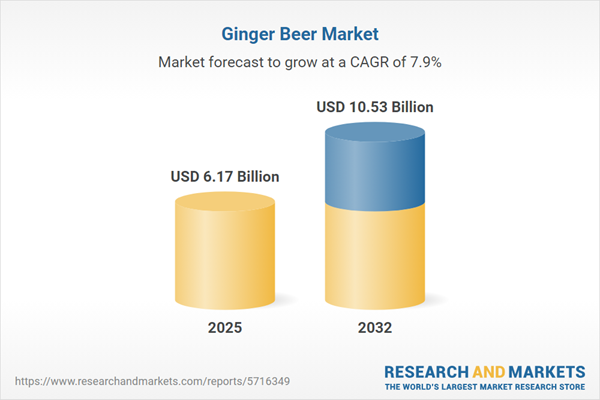Speak directly to the analyst to clarify any post sales queries you may have.
The ginger beer market is experiencing dynamic shifts as health-conscious buyers, digital commerce, and evolving competition reshape the landscape. Senior decision-makers need targeted insights to remain ahead of market demands and sustain innovation-driven performance.
Market Snapshot: Ginger Beer Market Size and Growth Drivers
The global ginger beer market is valued at USD 5.72 billion in 2024, with projections indicating an increase to USD 6.17 billion by 2025. The category is expected to demonstrate a CAGR of 7.93% through 2032. Growth reflects continued investment in recipe innovation, heightened interest in wellness-focused beverage choices, and rapid expansion of digital retail channels. Leading producers are adopting agile supply networks and refining their brands to stand out as buyer preferences and regulation evolve. As a result, the competitive landscape is marked by intensified operational efficiency and an accelerated pace of innovation from both established players and ambitious new entrants.
Scope & Segmentation: Strategic Insights for Ginger Beer Market Leaders
This report offers a clear structure for senior leaders to identify opportunities and mitigate risk across the sector. Building clarity around market segments and actionable trends enables sharper strategies and competitive advantage:
- Distribution Channels: Evaluate the effectiveness of e-commerce, direct-to-consumer models, leading supermarkets, specialty stores, convenience outlets, and strategic third-party and hospitality partnerships for optimizing market access.
- Packaging Types: Assess the implications of glass, PET, cans, and kegs for operational sustainability, brand perception, and compliance with shifting packaging regulations.
- Flavors: Analyze the impact of classic, fruit-infused, and spicy recipe variants to capture emerging consumer preferences and build brand diversity.
- Sugar Content: Examine low-sugar, zero-sugar, and regular formulas in the context of growing wellness awareness and navigate compliance challenges.
- Price Tiers: Develop positioning that leverages premium, standard, and superpremium ranges to refine targeting and expand campaign effectiveness.
- Organic Certification: Differentiate between organic-certified and conventional products to strengthen consumer trust and influence purchasing choices.
- Regional Coverage: Track buying patterns and regulatory trends across the Americas, Europe, Asia-Pacific, the Middle East, and Africa, informing regionally adaptive strategies.
- Key Companies: Benchmark the business models and strategic priorities of prominent players such as Fever-Tree Group PLC, Bundaberg Brewed Drinks Pty Ltd, Reed's, Inc., Gosling Brothers Limited, Fentimans Limited, Polar Beverages Corporation, Belvoir Fruit Farms Limited, East Imperial Co., Ltd., Thomas Henry GmbH, and Q Mixers LLC.
Key Takeaways for Senior Decision-Makers
- Expanding wellness-centric and organic product portfolios increases consumer trust and helps align product lines with regulatory best practices and buyer values.
- Developing compelling brand narratives and focusing on premium positioning supports market visibility and clear differentiation within an increasingly crowded sector.
- Utilizing analytics and sales automation technologies strengthens forecasting and demand planning, while helping ensure proactive and resilient supply chain operations.
- Investing in sustainable packaging and collaborating with the hospitality industry amplifies reputational value and bolsters supply chain flexibility.
- Introducing a broader range of flavors and innovating in flexible packaging options can enhance customer engagement and fuel successful product line extensions.
- Balancing digital and traditional sales channels equips businesses to adapt to evolving purchasing patterns, contributing to organizational agility and reduced disruption risk.
Tariff Impact: Navigating Regulatory and Supply Chain Changes
Forthcoming U.S. tariffs in 2025 are set to impact sourcing and cost structures, prompting both importers and domestic manufacturers to revisit supply strategies. Importing partners are strengthening coordination to manage potential market fluctuations, while domestic producers explore new strategic alliances. Keeping pace with regulatory changes and ensuring agile marketing responses are critical for minimizing disruptions from changing trade environments.
Methodology & Data Sources
This ginger beer market research synthesizes executive interviews, consumer surveys, and in-depth retail point-of-sale analytics. Additional guidance from industry specialists, scenario analyses, internal audits, and regulatory reviews ensures a robust, accurate, and actionable set of findings to inform decision-making.
Why This Ginger Beer Market Report Matters
- Empowers senior leaders to benchmark operations and identify new growth vectors in both mature and evolving segments of the ginger beer market.
- Enables leadership teams to strategically anticipate and adapt to shifting buyer behavior, supporting informed capital allocation.
- Strengthens risk management with comprehensive compliance and sustainability insight to adapt to ongoing industry change.
Conclusion
This market intelligence report provides actionable guidance for leaders aiming to capitalize on market trends, foster innovation, and build differentiation within the ginger beer sector.
Additional Product Information:
- Purchase of this report includes 1 year online access with quarterly updates.
- This report can be updated on request. Please contact our Customer Experience team using the Ask a Question widget on our website.
Table of Contents
3. Executive Summary
4. Market Overview
7. Cumulative Impact of Artificial Intelligence 2025
Companies Mentioned
The companies profiled in this Ginger Beer market report include:- Fever-Tree Group PLC
- Bundaberg Brewed Drinks Pty Ltd
- Reed's, Inc.
- Gosling Brothers Limited
- Fentimans Limited
- Polar Beverages Corporation
- Belvoir Fruit Farms Limited
- East Imperial Co., Ltd.
- Thomas Henry GmbH
- Q Mixers LLC
Table Information
| Report Attribute | Details |
|---|---|
| No. of Pages | 186 |
| Published | November 2025 |
| Forecast Period | 2025 - 2032 |
| Estimated Market Value ( USD | $ 6.17 Billion |
| Forecasted Market Value ( USD | $ 10.53 Billion |
| Compound Annual Growth Rate | 7.9% |
| Regions Covered | Global |
| No. of Companies Mentioned | 11 |









